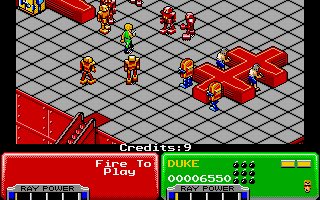
Author: GN Team - Published: 21 October 2021, 6:57 pm
Escape from the Planet of the Robot Monsters is an Atari coin-op released in 1989, ported to Amiga, CPC, Atari ST, C64, DOS, and other platforms.
The game was designed by Mark Stephen Pierce, also known for Klax and Dark Castle. This excellent Amiga conversion was developed by Teque, the same studio that made Brutal Sports Football, Shadowlands, Laser Squad, and many other titles.
Escape is a shoot-em-up for two players (yes, single-player is supported too, but co-op is much better). Unlike other 2-players shooters like Alien Breed, Escape from the Planet of the Robot Monsters uses isometric graphics. The sprites and background are detailed and colorful in a lovely cartoon style, similar to D/Generation.
Read More
Author: GN Team - Published: 14 October 2021, 1:14 pm
The first revolutionary Football Manager was created by Addictive Games in 1982 for the ZX Spectrum and then ported to many other platforms.
Kevin Toms created the first version of the game on a clone of the TRS-80. The official launch arrived only in 1982 when Kevin ported the game to the ZX81 and later for the ZX Spectrum, adding the animated highlights of the match. For the occasion, the author opened a new company called Addictive Games. A perfect title since the game was genuinely addictive!
The colossal success convinced the author to port the game to other computers. Two years later, the conversions for Commodore 64, Amstrad CPC, BBC Micro, Dragon 32, Oric were released. There will also be versions for MSX, MS-DOS, Atari 8-bit, Atari ST, Amiga during the following years.
Read More
Author: GN Team - Published: 3 October 2021, 10:52 pm
Aleste, released outside Japan as "Power Strike", is a popular shoot-em-up developed by Compile. It was released initially for the SEGA Master System in 1988. Later, it was published for MSX2.
An evil virus will wipe out humanity, and of course, saving the world will be up to you and your ship. But the plot is not very important in this vertical scrolling shooter full of enemies and challenging end-of-level bosses. Technically speaking, the game is perfect, scrolling and animations are smooth, and the action is furious. This is not an easy game. If you die in the middle of the level, you will lose all your weapons, so beating the boss will be almost impossible.
Read More
Author: GN Team - Published: 2 October 2021, 2:32 pm
X-Men is a videogame created by Western Technologies exclusively for the SEGA Mega Drive/Genesis console and published in 1993.
The title is based on the famous superheroes series by Marvel. The gameplay is a typical side-view beat-em-up/platformer, similar in many ways to other popular games such as Strider or Lionheart.
In this platformer, you can control four of the most famous mutants: Gambit, Nightcrawler, Wolverine, and Cyclops. Other heroes such as Storm, Rogue, Iceman, and Jean Grey, can't be played, but they occasionally appear to help you. The final boss is, as you can expect, the well-known Magneto.
Read More
Author: GN Team - Published: 30 September 2021, 7:35 pm
Gunship is a combat flight simulator created by MicroProse Software and released initially for the Commodore 64 in 1986. Later it was ported to PC, Amstrad CPC, ZX Spectrum, Atari ST, and other platforms.
The Amiga version was released in 1989, while the Mega Drive version by US Gold arrived in 1993. The game, that initially was not supposed to be military combat simulator, allows you to pilot the famous helicopter AH-64A Apache. Missions include scenarios in Middle East, South-East Asia, Central America, and Europe.
The title was a success, both in terms of sales and in terms of magazines reviews. Many considered it the best combat flight sim available at that time. Gunship was followed by Gunship 2000 in 1991.
Read More
Author: Gustavo - Published: 25 September 2021, 4:36 pm
Jill of the Jungle: Jill Goes Underground is the second chapter of the Jill of the Jungle trilogy, a series of side-scroller platformers. The games were designed to compete with Duke Nukem and Commander Keen. It was released in 1992 for MS-DOS only.
Today, it's time to review another of the first significant female figures in video games who are not just there to be rescued by the male protagonist. Will the second chapter of the franchise be as good as the first? Will it be an improvement on the original, considering how close they were released? Let's find out together.
Read More